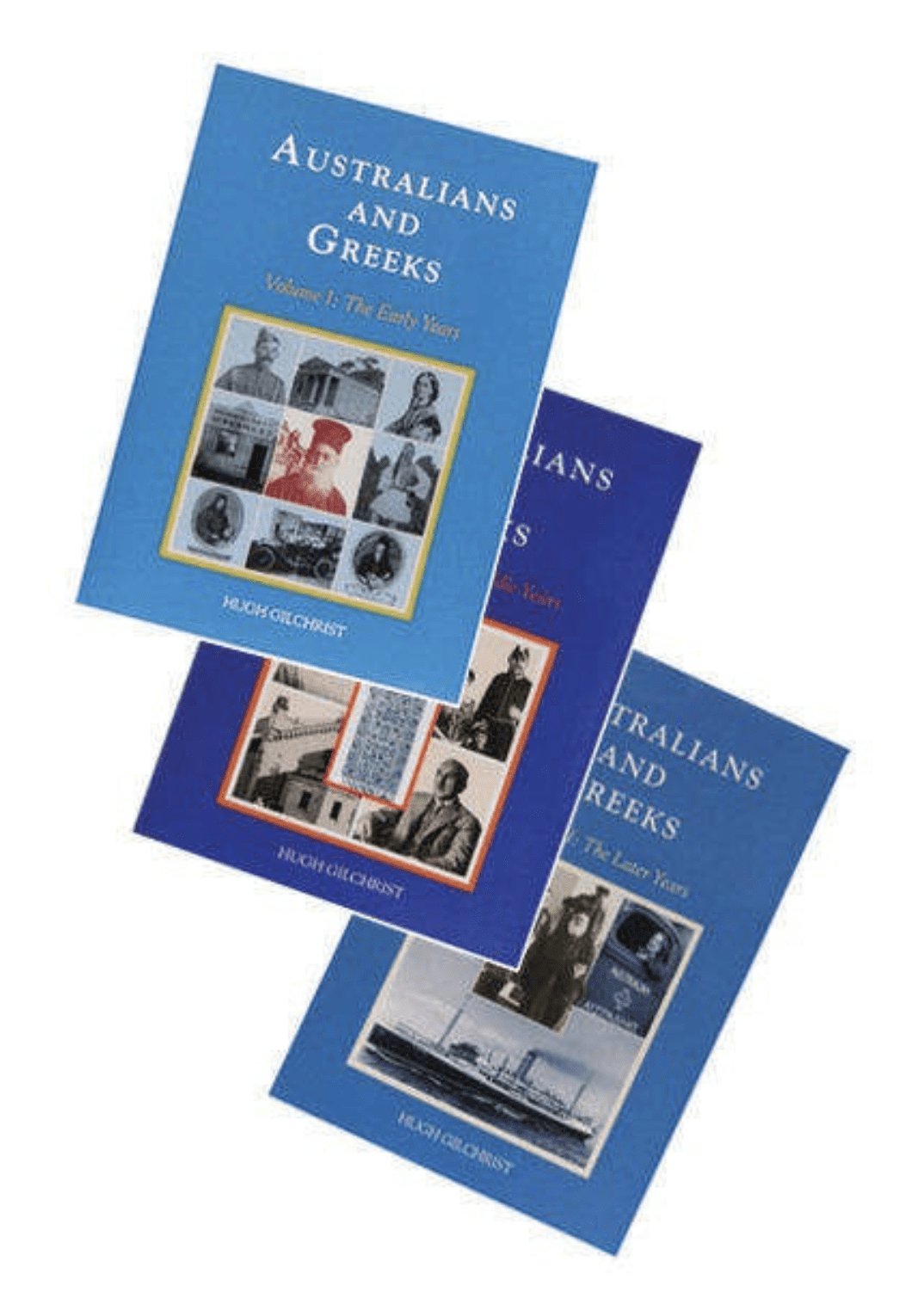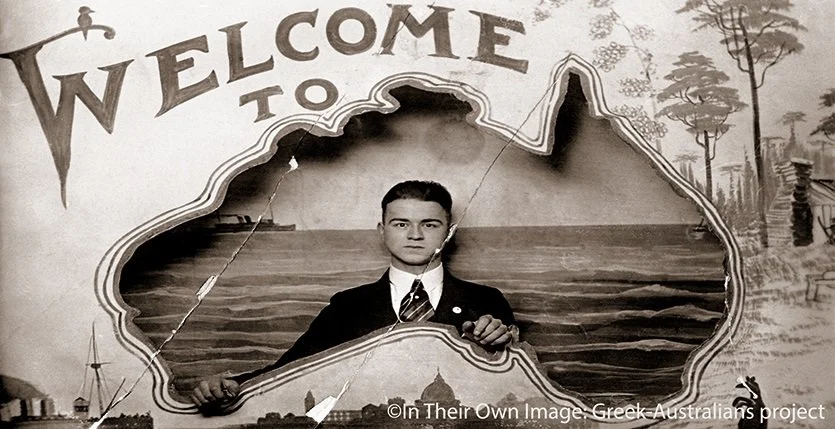Greek City Times is proud to present a weekly historical snapshot
from the archives of the ‘In Their Own Image: Greek Australians’ national project
by photographer Effy Alexakis and historian Leonard Janiszewski.
The story this week pays tribute to Hugh Gilchrist.

In 1985 we met Hugh Gilchrist in person at his home in Canberra. We had been in correspondence earlier and of course later until he passed away in 2010. Described as the ‘premier Greek-Australian historian of the 20th Century’, he was a career diplomat who spent many decades working on his 3 volume ‘Australians and Greeks’ publications. He was Australian Ambassador to Greece between 1968 – 1972.
In his obituary (2010), his daughter Athene Anderson (née Gilchrist) wrote:
“During his four years as the Greek Ambassador he became a passionate Philhellene. (Hence the name of his first born). With free time, he launched into research on the Greek presence in Australia. Amongst his first publications was a comprehensive article, "Australia's First Greeks" in the Canberra Historical Journal, 1977.
His reputation as the premier Greek-Australian historian of the 20th century followed the publication of ‘Greeks and Australians, Volume 1, The Early Years’, 1992; ‘Volume 2, The Middle Years’, 1997; and ‘Volume 3, The Later Years’, 2004. Reviews of these works included comments such as, “Hugh Gilchrist has virtually set the benchmark for study of major ethnic communities in Australian society and culture” and “Gilchrist has created a monumental and praiseworthy work of three volumes, which will be treasured not only by historians but also by the community at large, both in Australia and Greece.” It’s testimony to the quality of these works, that all three books have remained in print, since the date of publication. The debt that Greek-Australians owe to Hugh Gilchrist, for establishing an important role for them, in the Australian historical narrative, can never be repaid.”
In an interview published in ‘Antipodes’ magazine (Vol 43-44, Melb. 1998) Christos Fifis interviewed Hugh Gilchrist:
What made you start the project Australians and Greeks?
“It was nearly thirty years ago in Athens when an Athenian sociologist, Dr Anthony Pissanos, gave a talk on the occasion of Australia’s national day. In it he mentioned Diamantina Roma – the Greek wife of Queensland’s first Governor, the Australian Sixth Division’s campaign in Greece, and Prime Minister Menzies’ visit to Athens in 1955. Having occasionally thought of writing something, but lacking a theme (“O, that mine enemy would write a book!” wished a Roman politician), it occurred to me to ask a few questions: Who was the first Greek in Australia? the first Greek woman, shopkeeper, priest, consul? the first Greek ship, church, newspaper?
This began Volume I, conceived as a work of possibly a hundred pages, of some practical use to the Embassy in Athens as a source of background information. In time it extended to include the experiences of Australians in Greece. Eventually it had to split into two volumes, the first ending at the outbreak of the First World War. It was rejected by six leading publishers before Halstead Press accepted it.”
When did you first visit Greece?
“My first encounter with Hellenism was my accidental entry into the Ancient Greek class at Cranbrook School in Sydney in 1928 (I had mistaken it for the Geography class, but was persuaded to stay – for five years). The next was my posting to Greece early in 1949, by Dr Evatt, as the alternate Australian delegate to the United Nations Assembly to monitor incursions from Albania, Bulgaria and Yugoslavia and to pursue any opportunities of conciliation between Greece and those countries. Apart from many hours in endless committee meetings, I travelled around northern Greece in Dakota aircraft and in jeeps and sandbagged trucks, taking evidence from witnesses. I saw great distress and poverty and heard stories of devastation by war and civil war from villagers and soldiers. It was not until 18 years later that I returned as Ambassador to a much-changed Greece.”
Were there any significant differences between the early settlers of Greeks and those who came later?
“Certainly, those who came before 1919 were mostly from Kythira, Ithaca and Kastellorizo and those who came later included many from Asia Minor, Egypt, Cyprus, Thrace, Macedonia, Ipeiros and the Pelopponisos. These later were more diversified in their occupations and in their provincial origins, creating a more diverse community, and their ‘topikismos’, while encouraging local welfare organisations, at times weakened Hellenic unity. After 1945, it would seem another generation gap developed, between those already well established and those who arrived with few resources – almost economic refugees – and had to battle from the start.”

The three volume Australians and Greeks by Gilchrist has never been out of print since publication and is available from Halstead Press.
The information in this story kindly acknowledges Hugh Gilchrist’s daughter Athene Anderson and Mr Christos Fifis.
Photos: Effy Alexakis
Historical Research: Leonard Janiszewski
© In Their Own Image: Greek-Australians National Project Archives
ABOUT EFFY ALEXAKIS & LEONARD JANISZEWSKI
Since the early 1980s, Effy Alexakis, a photographer, along with historian researcher Leonard Janiszewski, have been travelling around Australia photographing and collecting stories. They have also photographed Greek-Australians in Greece and documented some amazing histories. The images and text provide personal, diverse and powerfully moving insights, about opportunities, hopes and challenges. Collectively, these stories provide personal perspectives of a diasporic Hellenic identity. Their archive encompasses photography, both historical and contemporary, taped interviews and literary materials.
They have published 3 books and numerous articles, and their projects are ongoing. The photographs have been widely exhibited throughout Australia and in Greece.
VISIT THEIR LATEST PROJECT: Greek Cafés & Milk Bars of Australia | Facebook


